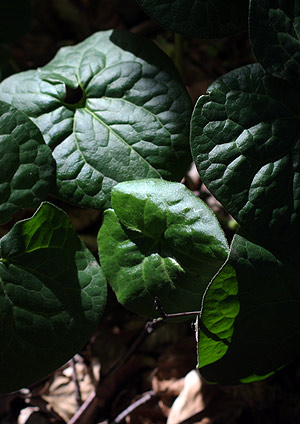
Asarum are a woodland plant commonly called ‘wild ginger’ they spread by underground rhizomes. Low growing, they are used as a groundcover, the large leaves being most attractive.
Asarum foliage (see picture right) is varied from plain greens to variegated and speckled forms.
Species including A. europeum and a. caudatum are popular as a ground cover plant in shaded areas.
Asarum maximum ‘Ling Ling’, Panda Face Ginger or ‘Panda faced ginger’ has the most spectacular flowers of all of the Asarum.
A. europaeum, A. canadense, A. caudatum and A.splendens with its green and silvery grey foliage is an attractive groundcover are all very popular in Japan where they are referred to as Asaramu.
Some of the Japanese Asarumu species have the most spectacular patterned or marbled foliage of all.
A Gardeners Perspective
Lynn McGough has been growing Asarums and other woodland plants for many years, she shares here experience with us.
This very under rated, rewarding & easy Genus grows in a wide range of habitats from cold to warm temperate. They prefer well drained soil in dappled shade, are low growing from a height range of around 6cm for Asarum shuttleworthii in my garden to the 40cm for my Asarum delavayi ‘Giant’.
Some species are evergreen, while others are completely herbaceous, some will form clumps & others such as Asarum caudatum travel along by underground roots, all have the most amazing flowers that sit under the leaves & are pollinated by flies, ants or other small insects that are attracted by the carrion smell released from the flowers, although the smell is unnoticeable to people or at least I can never detect it. Because the flowers have both male & female reproductive parts (Hermaphrodites) they can each produce seed without the need for both male & female plants.
Because the flowers grow at ground level under the leaves they cannot be easily seen, so I remove all of the leaves from the spring flowering evergreen species in mid to late winter. If you look down into the leaves you will see in late winter the flowers ready & waiting to open, so all the old tired previous year’s leaves are carefully removed so as I can enjoy the flowers & all the new fresh leaves will emerge before long.
Apart from the spectacular flowers, the leaves are also stunning they come in many shapes & sizes, heart shaped, arrow shaped and many have striking patterns in an assortment of greens & silvers.
While many will make great outdoor pot specimens I prefer planting them into the garden, where I fertilize them twice a year, spring & autumn along with the normal garden fertilizing regime.
Asarums are native to many parts of the globe, including Europe, Asia & America. The Japanese in particular regard them with reverence & have cultivated some of the most exquisite & rare forms, of which some are very expensive (Hundreds sometimes thousands of dollars) & rarely seen in gardens.
To Summarize:
Basic care means that Asarums like well drained semi-shaded to shaded conditions in Summer, in winter they can take the sun, so can be planted under deciduous trees or shrubs that will shade them in Summer.
Asarums hate wet boggy soil, so plant in a position that is well drained, if your soil is cloggy then dig in something that will keep the soil open & create good drainage.
As with most plants, when first planted give them some regular water until the roots start to spread into the new soil.
Fertilize at least annually with a general all round fertilizer (unless kept in a pot, then use something such as slow release pellet fertilizer) always making sure, as with any plants not to fertilize on very hot days or when the garden is dry, otherwise the roots of many plants will get burned when you water, as the dry roots get shocked with the strength of the fertilizer. If my garden is dry, I water the day before & then fertilize the following day and water again to help the fertilizer into the soil.
Varieties
Species and varieties include :
- Asarum canadense
- Asarum caudatum
- Asarum europeaum
- Asarum maximum ‘Green Panda’
- Asarum maximum ‘Ling Ling’
- Asarum naniflorum
- Asarum shuttleworthii
- Asarum splendens
- Asarum takaoi

